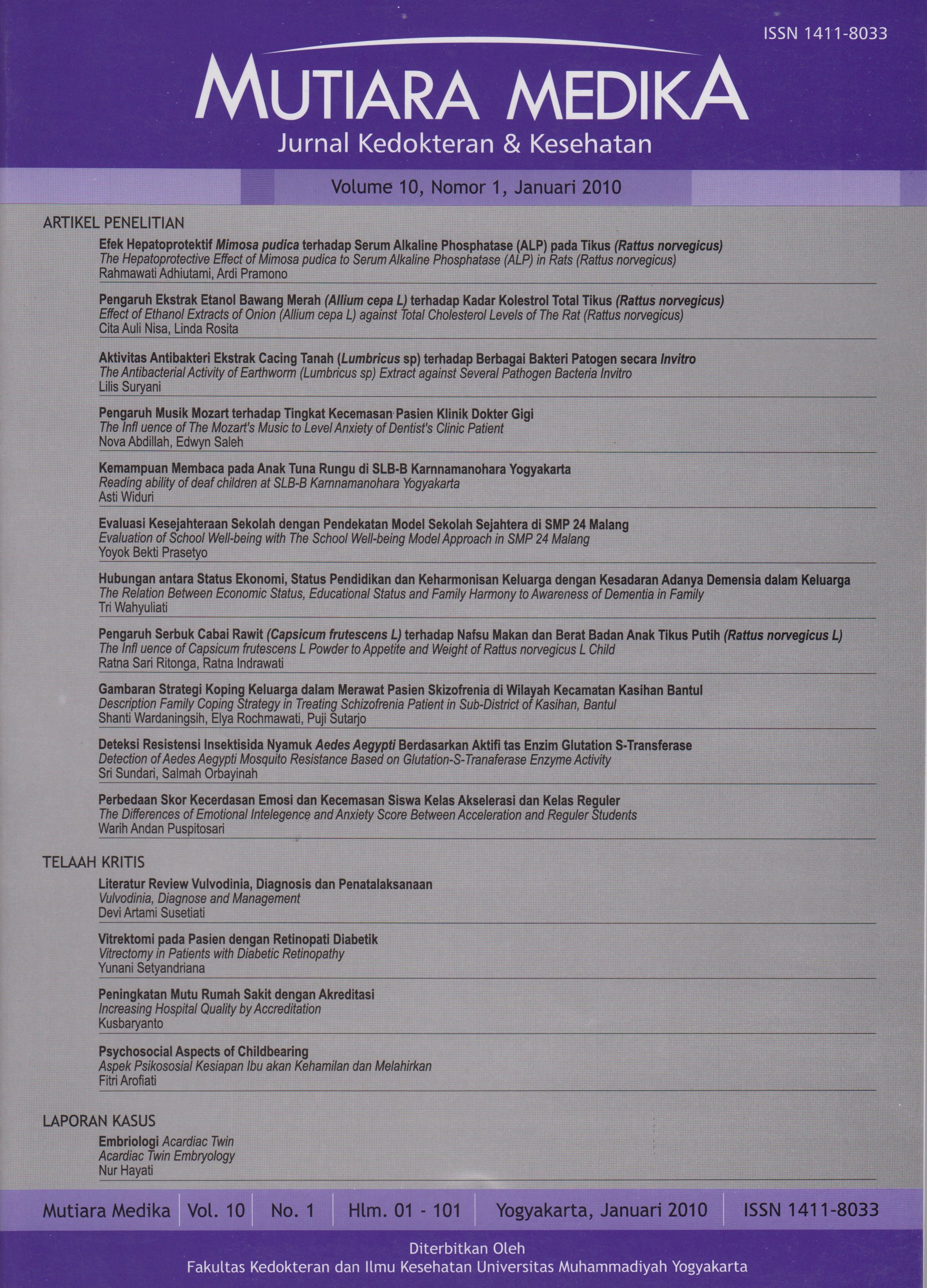Pengaruh Musik Mozart terhadap Tingkat Kecemasan Pasien Dokter Gigi
DOI:
https://doi.org/10.18196/mmjkk.v10i1.1557Keywords:
pasien dokter gigi, piranti, tingkat kecemasan, musik Mozart, dentist’s patient, instrument, level anxiety, Mozart’s musicAbstract
The aim of this study was to examine the influence of Mozart’s music as an instrument in reducing patient’s anxiety while visiting dentist’s clinic. 100 subjects between age of 13 - 70 years and fulfilled the inclusion criteria participated in this study. In this quasi-experimental study the subjects were questioned about their feeling of anxious before entered and after went out from the dentist’s practice room, while Mozart’s music playing during the treatment. Patient’s anxiety score were obtained by Modified Dental Anxiety Scale (MDAS). Data were evaluated using Wilcoxon Signed Rank Test. This study showed that there ’s changes ofpatient ’s anxiety level after listening Mozart’s music during dental treatment. One patient experienced increasing of dental anxiety levels, 48patients didn ’t experience of dental anxiety level changes, and 51 patients experienced decreasing of dental anxiety levels. Result of statistical test showed p=0,000 (p<0,5) it means that there ’s a significant differences ofpatient’s anxiety levels after dental treatment with Mozart ’s music playing in dentist ’s practice room. In conclusion, Mozart ’s music can be used as an alternative instrument to reduce anxiety levels of the patient during dental treatment at the dentist’s clinic.
Penelitian ini bertujuan untuk mengetahui pengaruh musik Mozart terhadap tingkat kecemasan pasien yang berkunjung ke klinik dokter gigi. Penelitian ini dilakukan dengan metode kuasi-eksperimental pada 100 pasien yang berusia 13 - 70 tahun dan memenuhi kriteria inklusi subjek penelitian. Pada subjek penelitian dilakukan penilaian terhadap kecemasan sebelum masuk dan sesudah keluar dari ruang praktek dokter gigi, dimana pada saat perawatan berlangsung, diputarkan musik Mozart. Skor kecemasan dinilai dengan Modified Dental Anxiety Scale (MDAS). Data yang diperoleh dianalisis dengan uji Wilcoxon Signed Rank Test. Hasil penelitian ini menunjukkan adanya perubahan tingkat kecemasan sesudah dilakukan perawatan dengan mendengarkan musik Mozart. Satu pasien mengalami peningkatan tingkat kecemasan, 48 pasien tidak mengalami perubahan tingkat kecemasan, dan 51 pasien mengalami penurunan tingkat kecemasan. Hasil uji statistis menunjukkan hasil p=0,000 (p<0,05) yang artinya terdapat perbedaan yang sangat bermakna pada perubahan tingkat kecemasan pasien sesudah diputarkan musik Mozart.Hasil penelitian ini dapat disimpulkan bahwa musik Mozart dapat digunakan sebagai alternatif piranti untuk mengurangi kecemasan pasien yang sedang melakukan perawatan kesehatan gigi di klinik dokter gigi.
References
Widayati. 2000. Pengaruh Pengetahuan terhadap Tingkat Kecemasan Pasien pada Saat Perawatan Gigi. Skripsi Strata Satu, Universitas Gadjah Mada, Yogyakarta;.
Karst, M., Winterhalter, M., Munte, et al. 2007. Auricular Acupuncture for Dental Anxiety: A Randomized Controlled Trial. International Anesthesia Research Society; 104(2): 295-300.
Kaplan, H.I, Sadock, J.B, Grebb, J.A. 1997. Sinopsis Psikiatri edisi 7 (Widjaja K, Trans.). Jakarta: Binarupa Aksara;.
Hmud, R., Walsh, L. 2007. J. Dental Anxiety: Causes, Complications and Management Approaches. International Dentistry SA; 9(5): 6-14.
Haun, M. 2001. Effect of Music on Anxiety of Women Awaiting Breast Biopsy. Behavioral Medicine; 3: 1-8.
Rodriguez-Vazquez, L.M., Rubinos- Lopez, E, Varela-Centelles A, et al.
Stress Amongst Primary Dental care Patients. Med Oral Patol Oral Cir Bucal; 13(4): E253-6.
Junaidi. 2008. Efek Terapi Musik Langgam Jawa terhadap Penurunan Tingkat Kecemasan pada Lanjut Usia. Karya Tulis Ilmiah strata satu, Universitas Muhammadiyah Yogyakarta. In press.
Marwah, N., Prabakhar, A.R., Raju, O.S. 2005. Music Distraction-its Efficacy in Management of Anxious Pediatric Dental Patients. J Indian Soc. Pedod Prev Dent; 168-170.
Latifa, W., Soemartono, S.H., Sutadi, H. 2006 Pengaruh Musik terhadap Perubahan Kecemasan dalam Perawatan Gigi pada Anak Usia 8-10 Tahun. JITEKGI; 3(3): 125-128.
Grzesiak-Janas, G., Jans A.. Muzyka. 2002. Mag. Stomat; nr10(132): 60.
Prasetyo, E.P. 2005. Peran musik Sebagai Fasilitas dalam Praktek Dokter Gigi untuk Mengurangi Kecemasan Pasien. Maj. Ked. Gigi. (Dent. J.); 41¬44.
Guyton, A.C, Hall, J.E. 2005. Buku Ajar Fisiologi Kedokteran. (9th ed), (Irawati Setiawan, dkk). Jakarta: EGC.
Habe, K., Jausavec, N. 2003. Mozart effect-reality or science fiction?. Horizons of Psychology; 12(4): 23-32.
Dailey, Y.M., Humphris, G.M., Lennon, M.A. 2002. Reducing Patients’ State Anxiety in General Dental Practice: A Randomized Controlled Trial. J Dent Res; 81(5):319-322.
Kanegane, K., Penha, S.S., Borsatti, M.A., Rocha, R.G. 2003. Dental Anxiety in an Emergency Dental Service. Rev Saude Publica; 37(6).
Bergenholtz, G. 2003. Textbook of Endodontology. Copenhagen: Blackwell Pub Professional.
Ganong, W.F. 1998. Buku Ajar Fisiologi Kedokteran. (17th ed), (Widjajakusumah M Djauhari, dkk). Jakarta: EGC.
Bare, L.C. Dundes, L. 2004. Strategies for Combating Dental Anxiety. Journal of Dental Education; 68(11): 1172-1177.
Jenkins, J.S. 2001. The Mozart Effect. Journal of the Royal Society of Medicine; 94: 70-172.
Downloads
Published
Issue
Section
License
Copyright
Authors retain copyright and grant Mutiara Medika: Jurnal Kedokteran dan Kesehatan (MMJKK) the right of first publication with the work simultaneously licensed under an Attribution 4.0 International (CC BY 4.0) that allows others to remix, adapt and build upon the work with an acknowledgment of the work's authorship and of the initial publication in Mutiara Medika: Jurnal Kedokteran dan Kesehatan (MMJKK).
Authors are permitted to copy and redistribute the journal's published version of the work (e.g., post it to an institutional repository or publish it in a book), with an acknowledgment of its initial publication in Mutiara Medika: Jurnal Kedokteran dan Kesehatan (MMJKK).
License
Articles published in the Mutiara Medika: Jurnal Kedokteran dan Kesehatan (MMJKK) are licensed under an Attribution 4.0 International (CC BY 4.0) license. You are free to:
- Share — copy and redistribute the material in any medium or format.
- Adapt — remix, transform, and build upon the material for any purpose, even commercially.
This license is acceptable for Free Cultural Works. The licensor cannot revoke these freedoms as long as you follow the license terms. Under the following terms:
Attribution — You must give appropriate credit, provide a link to the license, and indicate if changes were made. You may do so in any reasonable manner, but not in any way that suggests the licensor endorses you or your use.
- No additional restrictions — You may not apply legal terms or technological measures that legally restrict others from doing anything the license permits.






